Playing First Base
Defensive Position
Not Holding a Runner On
You want to play deep enough that you can cover as much ground as possible, while being shallow enough to make it to first base prior to a throw being made from a position player. It would be difficult for a shortstop for example to have to make a throw to first base if you are still running there while he is delivering the ball. You need to get in position to give the position player a target to throw to.
Even though we want to be able to depend on the pitcher to cover first base on a ball you field to your right, we don't want to have to depend on him for every ball hit your way. Young pitchers will often forget to cover the base. Make sure you are shallow enough that you can catch the routine ground ball and tag the base yourself.
Holding a Runner On
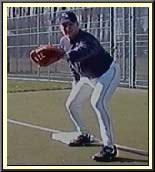
Right-handed first baseman: Position your right foot against the bag with both heels about parallel to the base line. You want to be in an athletic position with your knees bent.
Left-handed first baseman: Position your right foot against the bag. Since you will be sweeping a tag with your right arm, you can open up more toward the pitcher.
As the pitcher goes into his stretch give him a target.
If he goes to the plate shuffle a few steps toward second base and get ready to field any ball hit your way.
Playing First Base
The following is a good video on some important aspects of playing first base by Don Mattingly.
Receiving The Throw
When catching the ball from infielders, you need to get to the bag as quickly as possible. Once there, turn and face the direction the ball is coming from. Make sure you do not stand on the bag in a position that doesn't allow the runner room to run by. Place your throwing hand foot on the edge of the base. Make sure you are in an athletic stance ready to move (don't assume the ball will be thrown right to you). You shouldn't stretch for the baseball until it is well on the way.
The image below shows a first baseman waiting for a throw from second and from third. No stretch will be made until the ball is on the way.
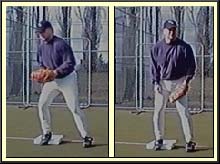
Player Tip
Two common mistakes are made by many players:
1. Stretching towards the ball too soon.
This puts you in a position of no return. Say for example a throw is made directly at you. You stretch out to catch the ball and realize that the ball is going to hit the dirt and it's not going to be an easy short hop. Your stuck. There is no adjustment that you can make other than trying to knock it down the best you can. If you would have waited, you would have options on how to field the ball.
2. Trying to stretch as far as you can on every play.
On a bang bang play, stretching for the ball can be the difference between out and safe. On balls thrown off target it is necessary in order to keep your foot on the base. On plays that aren't close and the ball is thrown at you, stretching out only adds a level of difficulty that's not necessary to get the out.
Example: Ball Coming From The Shortstop
If the shortstop throws the ball directly at you or to your glove hand side, step out with your left foot (for a right-handed first baseman) in the direction of where you want to catch the ball. So, if the ball was thrown a few feet on the home plate side of first, you may need to step towards home (not directly down the line) to make the catch.
On a ball thrown to your throwing hand side, step across your body and catch the ball backhanded.
The image to the below shows an example of stepping towards each type of ball described.
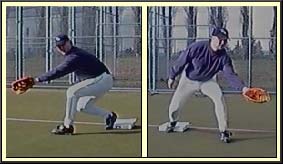
Pulled Off The Bag
Sometimes the throw is so off line that the first baseman must leave first base to catch the ball. Many times just catching the ball will be difficult enough, but in some cases the first baseman may still be able to get the out.
Pulled Off Towards Home
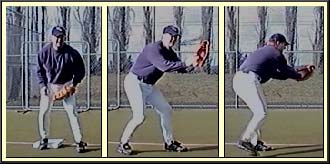
If you're pulled off the base towards home, you may be able to catch the ball and make the tag on the runner as he goes by. When making this play remember the following:
- Don't get in the base line.
- As you catch the ball, place your throwing hand in your glove over the ball to secure it before making the tag.
- Try to tag the runner in the hip area as he goes by.
Balls In The Dirt
It would be great if you always received the ball chest high from the other fielders on a throw to first. Unfortunately there are many times when the ball hits the dirt before it hits your glove. As a first baseman, this play has the greatest impact on how coaches, teammates, and fans judge your defensive ability. While you won't have an error under your name if you can't come up with the ball in the dirt, it still reflects on your ability. Although you won't field all these "dirt" balls cleanly, it is a skill you should master to the best of your ability.
The following is a good video on the correct positioning, footwork and how to pick a ball that is thrown in the dirt.
The Short Hop
When fielding a throw that is going to hit the ground, you will be forced to make the best of a difficult play. When fielding a ground ball you can move up or back to keep from fielding the ball on a short hop. When fielding a thrown ball you are limited in your ability to move since you are trying to keep your foot on the base.
As the ball comes toward you, quickly determine where it will hit the dirt. If you cannot stretch out far enough to catch it in the air, stretch out toward the ball or stride out at an angle that puts your glove in a position to catch the ball just after it hits the ground. The closer you can get to catching the ball as it hits the ground, the easier it will be to catch.
As the ball hits the dirt, move your glove forward and at a downward angle toward the ball. This allows you to catch the ball right after it hits the ground and most importantly keep it in your glove. When catching the ball in this manner, you don't want to stretch out and then have your glove give or have it angled up. This most likely will result in the ball bouncing off your glove.
Can't Catch it on the Short Hop
The video above explains how to catch the ball as you are partially stretched out toward the throw. This is important as it can be difficult to know exactly where a ball is going to hit when the ball is in the air. If you cannot stretch out in order to catch the ball on a short hop, then modify your approach. Instead of stretching out and trying to catch the ball just after it hits the ground, you will want to stay close to the base. This will give you extra space after the ball has bounced before you have to catch it. In this case footwork is very important. You want to put yourself in a good position to field the ball and at least knock it down. Try to position your body in front of the throw. You are going to act like you are fielding a ground ball, with the difference being your foot is on the bag. The image above shows an example of fielding this type of throw.
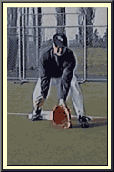
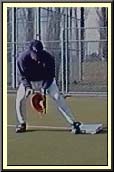
If you're a right-handed first baseman and the ball is thrown to the outfield side of first base, you may want to switch your feet, placing your left foot on bag. This will allow you to get in front of the ball thrown to the outside. The same footwork is required for a left-handed first baseman catching the ball on the home plate side of first.
From the Catcher
Occasionally you will need to catch a ball that has been fielded by the catcher. This could be on a bunt out in front of the base or a dropped third strike. After fielding the ball close to the first base line, the catcher will need to move to one side of the foul line or the other to make sure his throw will not hit the runner. You will need to position yourself the same side of the foul line that the catcher is on. If he is in foul territory, step across the base well before the runner gets there and use your right foot to touch first. If the catcher is in fair territory, use your left foot to contact the bag. Always give the first base to the runner.
Making The Out At First
3 Unassisted
If you field the ball and have time to beat the runner to first, you should. This is a much safer play than throwing it to the pitcher covering the bag.
- Make sure you catch the ball first. Hustle to the bag after you have fielded the ball. Don't hurry the catch.
- Never run across the bag in front of the runner. Always stay in fair territory and reach out to touch the base and then step back or to the side.
Feeding The Pitcher
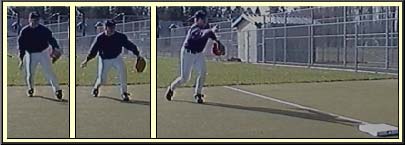
There are times when you won't be able to beat the runner to the bag and will have to throw the ball to the pitcher. Sometimes you will be able to underhand the ball and sometimes you will have to throw it. Either way it is important to remember:
- Always lead the pitcher. The pitcher is running at an angle toward first base, not towards the ball. Aim so he can catch the ball in stride.
- Throw the ball on the infield side of the base. If you throw the ball over the base or in foul territory, you put your pitcher in a dangerous position.
- Always try and get the ball to the pitcher before he reaches first base. It's a very difficult play for the pitcher to try and catch the ball on the run and touch first base at the same time.
- When throwing the ball underhand, you will improve your accuracy by following your throw. So as you deliver the ball, let your back foot come forward and walk towards the base.
Starting the Double Play
A left-handed first baseman has a real advantage in starting a double play. When fielding a ground ball he is already lined up for the throw to second, where the right-handed first baseman must turn to make the throw.
There are two ways to make this play.
1. The first is for any ball hit to your right. On this play, you will field the ball, make the throw to the inside part of second base if you were holding the runner on or to the outside part of second if you were playing behind. After making the thrown hustle back to first for the return throw.
2. The second is for any ball hit to your left. On this play you are so close to first base that you can field the ball, touch first base for the out and then make the throw to second. Make sure you call out "tag" as you make the throw to second. This lets the shortstop know that he must tag the runner to complete the double play.
On this play the runner will be farther down the base line. Make sure you step inside or outside the baseline after you touch the bag to make the throw. This will give you a clear path to throw the ball to second base. If you step inside then throw the ball to the inside of second. If you step outside throw the ball to the outside of second. The shortstop will see which side you're on and position himself towards that side of the bag.
Most Recent Blog Posts
Working With Players on Focusing on the Correct Part of the Baseball when Hitting (October 15 2016)
Getting More Accurate Throws From Your Team (April 5 2016)
Youth Coaching Advice
Work on balls being thrown to the side of the first baseman. Make sure he does not step in the baseline on either side of the bag. It's a sure way for the runner to end up colliding with him. It's a dangerous situation for both players, so make sure all your first basemen know where to step to receive the ball.
Thanks for all the great information and drills! I've used the site all season and it's made my life so much easier.
- Jim N.
Youth Coaching Advice
On any ball hit to the right of the first baseman, you may want to have the pitcher always cover first. This way your first baseman can focus on fielding the ball and making a good throw to second. It's also good training for the pitcher to get used to covering first on that play.







